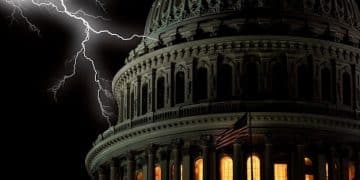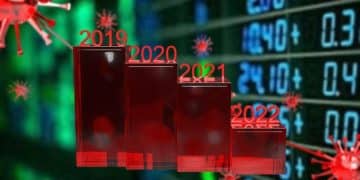Education Dept. Announces Key Student Loan Forgiveness Changes

The Department of Education has unveiled significant adjustments to its student loan forgiveness programs, impacting millions of borrowers through revised eligibility criteria, simplified application processes, and accelerated timelines for debt relief, aiming to provide broader and more accessible financial relief.
For many Americans, student loan debt presents a substantial financial hurdle, shaping life choices from career paths to family planning. The recent announcement from the Department of Education regarding changes to the student loan forgiveness program marks a pivotal moment, offering a potential beacon of hope for millions. These modifications are not merely procedural; they represent a significant policy realignment designed to streamline, expand, and accelerate access to debt relief that has long been sought after by borrowers across the nation.
Navigating the New Landscape of Loan Forgiveness
The landscape of student loan forgiveness has historically been complex, often perceived as a labyrinth of intricate rules and opaque eligibility requirements. This complexity frequently led to frustration and, in many cases, outright denial of relief for deserving borrowers. The Department of Education’s recent reforms aim to demystify this process, making it more intelligible and equitable for those striving to shed the burden of educational debt.
Understanding these changes is crucial for current and prospective loan holders. The reforms touch upon several key aspects, ranging from how payments are counted to the types of loans that qualify for specific relief programs. This comprehensive approach suggests a broader strategy to address systemic issues within the student loan system, moving beyond piecemeal solutions toward a more cohesive and borrower-friendly framework.
Key Changes to Eligibility Criteria
One of the most impactful adjustments involves the reevaluation of eligibility criteria for various forgiveness programs. Previously, strict adherence to specific repayment plans or employment sectors often limited who could qualify. The new guidelines broaden the scope, allowing a wider range of borrowers to pursue relief options.
- Expanded Payment Counts: More types of pre-consolidation payments and periods of deferment or forbearance may now count towards forgiveness timelines, effectively bringing many borrowers closer to their relief goals.
- Simplified Income-Driven Repayment (IDR) Qualification: New IDR plans are being introduced, or existing ones modified, to offer more generous terms, potentially reducing monthly payments and accelerating forgiveness for those with lower incomes relative to their debt.
- Inclusion of Previously Excluded Loans: Certain federal loan types, which were historically difficult to discharge or consolidate into forgiveness-eligible categories, are now being integrated under the new rules, providing relief to a demographic previously left behind.
Beyond these technical adjustments, the underlying philosophy appears to be a shift towards a more inclusive and practical application of forgiveness policies. This is a direct response to years of advocacy from borrower rights groups and a recognition of the significant economic pressures faced by millions.
Streamlining the Application Process
Another significant hurdle for borrowers has been the often cumbersome application process. Lengthy forms, requirements for extensive documentation, and a lack of clear guidance frequently deterred individuals from applying, even if they met the criteria. The Department of Education has committed to overhauling this aspect, aiming for a more user-friendly experience.
The revised application procedures are expected to be simplified, potentially leveraging existing federal data to pre-populate information or reduce the need for manual submissions. This change could dramatically decrease the administrative burden on borrowers and the processing time for the Department itself, leading to faster approvals and disbursements of relief.
- Automated Data Integration: Efforts are underway to automatically credit eligible payments using federal loan data, reducing the need for borrowers to manually track and submit years of payment records.
- Online Portals and Digital Tools: Enhanced online platforms are being developed to facilitate easier application submission and status tracking, providing transparency and accessibility.
- Proactive Outreach: The Department plans to actively identify and notify eligible borrowers about their potential for forgiveness, moving away from a purely reactive, applicant-driven model.
These improvements signify a departure from past models, recognizing that a more efficient system benefits both the government and its citizens. By reducing friction in the application process, the Department aims to ensure that eligible individuals can more easily access the relief they are due.
Impact on Different Forgiveness Programs
The announced changes are not uniformly applied but rather tailored to different existing forgiveness programs, each with its unique objectives and target demographics. Understanding how these reforms intersect with programs like Public Service Loan Forgiveness (PSLF), Income-Driven Repayment (IDR) forgiveness, and specific debt relief initiatives is crucial for borrowers to identify their best path forward.
These adjustments reflect a nuanced understanding of the varying needs and circumstances of borrowers, indicating a move towards a more flexible and responsive system. The goal appears to be maximizing the reach and effectiveness of each program, ensuring that relief is targeted where it is most needed and deserved.
Public Service Loan Forgiveness (PSLF) Enhancements
The PSLF program, designed to erase debt for those working in public service, has historically been plagued by low approval rates and complex rules. The new changes are poised to significantly improve outcomes for PSLF applicants, acknowledging the vital contributions of public sector employees.
The primary focus for PSLF enhancements includes a more generous counting of qualifying payments, including periods that might have previously been overlooked or deemed ineligible due to administrative errors or nuanced program interpretations. This retroactive adjustment is expected to result in widespread relief for many who have dedicated years to public service.
- Broader Employer Definitions: Clarifications or expansions in what constitutes a qualifying employer could bring more individuals under the PSLF umbrella.
- Easier Payment Certification: Streamlined processes for certifying employment and payments will reduce administrative burdens and errors.
- Retroactive Credit for Past Payments: Many past payments that didn’t previously count due to specific loan types or repayment plans are now being re-evaluated, offering a lifeline to long-serving public servants.
These PSLF reforms acknowledge the past challenges and signal a genuine commitment to fulfilling the program’s original promise, ensuring that those who commit to public service are appropriately rewarded with debt relief.

Income-Driven Repayment (IDR) Forgiveness Adjustments
IDR plans aim to make loan payments affordable based on a borrower’s income, with any remaining balance forgiven after a certain number of years (typically 20 or 25). The adjustments to IDR forgiveness are among the most significant, promising accelerated relief for millions of borrowers, particularly those with longstanding debts.
The key innovation here is the Department’s initiative to conduct a one-time account adjustment for all borrowers on IDR plans. This adjustment will rectify past administrative errors and ensure that all eligible payments are correctly counted, including periods of forbearance and deferment that historically did not count towards forgiveness. This means many borrowers will find themselves much closer to, or even immediately eligible for, forgiveness than they previously thought.
The new rules could also introduce more favorable terms for monthly payments, potentially lowering the discretionary income calculation and thereby reducing the amount borrowers owe each month. This dual approach of accelerating forgiveness and making monthly payments more manageable aims to provide holistic relief for borrowers struggling with high debt loads relative to their earnings. This strategic move by the Department seeks to alleviate the financial strain on individuals, fostering greater economic stability and enabling them to invest in their futures with more confidence.
Furthermore, the Department is considering new IDR plans that might further simplify the process and reduce the time to forgiveness for certain populations. This continuous evaluation reflects an ongoing commitment to evolving the student loan system to better serve the contemporary financial realities of borrowers, addressing the complexities and shortcomings of past policies to create a more accessible and fair system for everyone affected by student loan burdens.
Addressing Past Systemic Failures
A significant driver behind these changes is the acknowledgement of systemic failures within the student loan ecosystem, which have historically prevented many eligible borrowers from receiving the forgiveness they were due. These failures range from administrative inefficiencies to a lack of transparency and clear communication regarding program requirements.
The Department of Education’s proactive approach to identifying and rectifying these issues signals a new era of accountability and borrower advocacy. By addressing past shortcomings, the aim is to rebuild trust and ensure that the promise of loan forgiveness is genuinely delivered to those who qualify, fostering greater financial stability for millions of Americans who have been burdened by educational debt for far too long. This decisive action is a critical step towards a more equitable and supportive system.
Rectifying Administrative Missteps
One of the most common complaints from borrowers has been the inconsistent and often erroneous counting of payments, especially under IDR plans. The one-time account adjustment is designed to correct these historical inaccuracies, providing a much-needed reset for millions of accounts.
This adjustment goes beyond simply counting payments; it retroactively applies new rules to past periods of forbearance and deferment, which were often granted by servicers but did not count towards forgiveness. By rectifying these missteps, the Department aims to ensure that no borrower is penalized for administrative errors or confusing guidance from loan servicers. This reflects a commitment to fairness and to upholding the integrity of the forgiveness programs.
- Correction of Payment Counts: An expansive review of borrower accounts will ensure accurate counting of qualified payments, including those previously miscategorized or missed.
- Addressing Forbearance Steering: Periods where borrowers were inappropriately steered into forbearance instead of IDR plans will now count towards forgiveness, preventing long-term penalties.
- Enhanced Oversight of Loan Servicers: Increased scrutiny and new requirements for loan servicers are being implemented to prevent future misguidance and ensure consistent application of rules.
These concentrated efforts to rectify administrative errors are a testament to the Department’s commitment to prioritizing borrower welfare, ensuring that the path to forgiveness is clear and accessible.
Improving Borrower Communication and Support
A critical component of the reform strategy is improving how the Department communicates with and supports borrowers. Historically, information about complex forgiveness programs was often difficult to find or understand, leading to widespread confusion and missed opportunities for relief.
The new initiatives plan to utilize plain language in all communications, establish clearer online resources, and proactively inform borrowers about their eligibility and the steps they need to take. This emphasis on transparency and support is foundational to ensuring that the benefits of the new policies reach the intended recipients effectively and efficiently, marking a significant step towards a more borrower-centric approach. The Department’s commitment to simplifying information will help millions of Americans navigate complex financial landscapes.
Furthermore, there’s a push to enhance the training and resources available to student loan servicers, ensuring they provide accurate and consistent advice to borrowers. This collaborative approach recognizes that effective implementation of these reforms relies not only on policy changes but also on the quality of direct interaction borrowers have with the system.
This holistic improvement in communication and support aims to empower borrowers, providing them with the necessary tools and information to navigate the forgiveness process confidently. By fostering clearer understanding and better guidance, the Department seeks to prevent future frustrations and ensure that eligible individuals can more easily access their deserving benefits.
Future Outlook and Potential Challenges
While the recent announcements are largely positive, they also usher in a period of adaptation, both for the Department of Education and for borrowers. The successful implementation of these changes requires sustained effort, clear communication, and the ability to address unforeseen challenges. The future outlook presents a mix of optimism for millions seeking relief and recognition of the work still required to fully realize the potential of these reforms.
The Department acknowledges that this is an ongoing process, and continuous review and adjustment will be necessary to ensure the policies achieve their intended impact. This forward-looking perspective suggests a commitment to refining the system based on real-world outcomes and borrower feedback.
Anticipated Timeline for Implementation
Many of the announced changes, particularly the one-time IDR account adjustment, are complex and will roll out in phases. While some borrowers may see immediate benefits, others will experience changes over the coming months and years as the Department systematically reviews millions of accounts.
It is crucial for borrowers to stay informed about these timelines and understand when they can expect to see adjustments to their loan balances or eligibility for forgiveness. The Department has indicated it will communicate directly with affected borrowers as their accounts are reviewed and changes are applied. This staggered approach is designed to manage the immense administrative undertaking involved in processing such widespread adjustments, ensuring accuracy and efficiency in the delivery of relief to those who qualify, making the process smoother for everyone involved.
- Phased Rollout: Complex adjustments, such as the one-time IDR count, will be implemented incrementally, with updates provided as specific groups of borrowers are processed.
- Direct Communication: Borrowers will receive direct notifications from the Department regarding changes to their loan status or eligibility as their accounts are reviewed.
- Dedicated Resources: New online resources and support channels are expected to be launched to provide ongoing updates and answer borrower questions about specific timelines.
Understanding these timelines is key to managing expectations and leveraging the new opportunities provided by the reforms. Borrowers should actively monitor official communications from the Department of Education and their loan servicers.

Potential Hurdles and What to Expect
Despite the positive intent, the implementation of such large-scale changes is rarely without its challenges. Borrowers should be prepared for potential administrative delays, further refinements to policies, and the possibility of needing to actively engage with their loan servicers to ensure their accounts are correctly updated.
One potential hurdle is the sheer volume of accounts to be reviewed, which could strain the administrative capacity of loan servicers and the Department itself. Another challenge could be effectively communicating the nuances of these complex changes to a diverse borrower population, ensuring that everyone understands how they are affected and what actions, if any, they need to take. It is vital for borrowers to remain vigilant and proactive, regularly checking their loan statuses and official communications. This approach will help ensure they benefit fully from the new policies and that any discrepancies in their accounts are promptly addressed, preventing unforeseen issues.
The Department has emphasized its commitment to transparency and responsiveness during this transition. However, borrowers would be well-advised to proactively educate themselves, utilize official resources, and directly engage with their loan servicers if they have questions or notice discrepancies. This proactive approach will be essential in navigating the evolving landscape of student loan forgiveness and maximizing the benefits available under the new policies. Staying informed and engaged will help guarantee the smooth application of these critical reforms, making a real difference for millions.
| Key Point | Brief Description |
|---|---|
| 🌍 Eligibility Expansion | Broader criteria now cover more loan types and payment periods for forgiveness. |
| 🚀 Streamlined Process | Simplified applications and automated data reviews for faster relief. |
| ⏰ Accelerated Forgiveness | One-time IDR account adjustment speeds up timeline for many borrowers. |
| 🤝 Rectifying Past Errors | Addressing old administrative missteps to ensure fair payment counts. |
Frequently Asked Questions About Loan Forgiveness Updates
▼
Eligibility has been broadened, particularly for those in Income-Driven Repayment (IDR) plans and Public Service Loan Forgiveness (PSLF). More payment types and periods of forbearance/deferment now count. The best way to determine your specific eligibility is to review official communications from the Department of Education or your loan servicer, as criteria can vary by individual loan history.
▼
The one-time IDR account adjustment will systematically review past payments, including certain periods of deferment and forbearance that previously didn’t count. This could retroactively add months towards your accumulated payment count for IDR forgiveness, potentially accelerating your path to debt relief. Some borrowers may even become immediately eligible for forgiveness as a result of this review.
▼
These changes primarily apply to federal student loans. While Direct Loans are most directly impacted, some reforms extend to commercially held FFEL Program loans and Perkins Loans if they are consolidated into a Direct Consolidation Loan. Private student loans are not subject to these federal changes. It’s advisable to check your specific loan types with your servicer to understand applicability.
▼
For most borrowers, especially those on IDR plans, the one-time adjustment will be automatic. However, if you have commercially held FFEL or Perkins Loans, you may need to consolidate them into a Direct Consolidation Loan by a specific deadline to benefit. Always keep your contact information updated with your loan servicer and monitor their communications for personalized guidance and instructions.
▼
The implementation of these changes is phased. While some immediate benefits may be noticed by certain borrowers, the broad impact of the one-time IDR account adjustment and other extensive reviews will extend over the coming months. The Department of Education aims to complete the major adjustments for most borrowers by a specified future date, which will be communicated broadly.
A New Dawn for Student Loan Borrowers
The recent announcement by the Department of Education signals a significant reorientation in the federal approach to student loan debt. These comprehensive changes, spanning eligibility criteria, application processes, and the rectification of past administrative failures, aim to deliver tangible relief to millions of Americans. By broadening access to forgiveness programs and streamlining their implementation, the Department is taking decisive steps towards a more equitable and efficient system. While the path to full implementation may present challenges, the underlying commitment to alleviating the student debt burden offers a renewed sense of hope and financial liberation for borrowers across the nation, paving the way for greater economic stability and opportunity.





